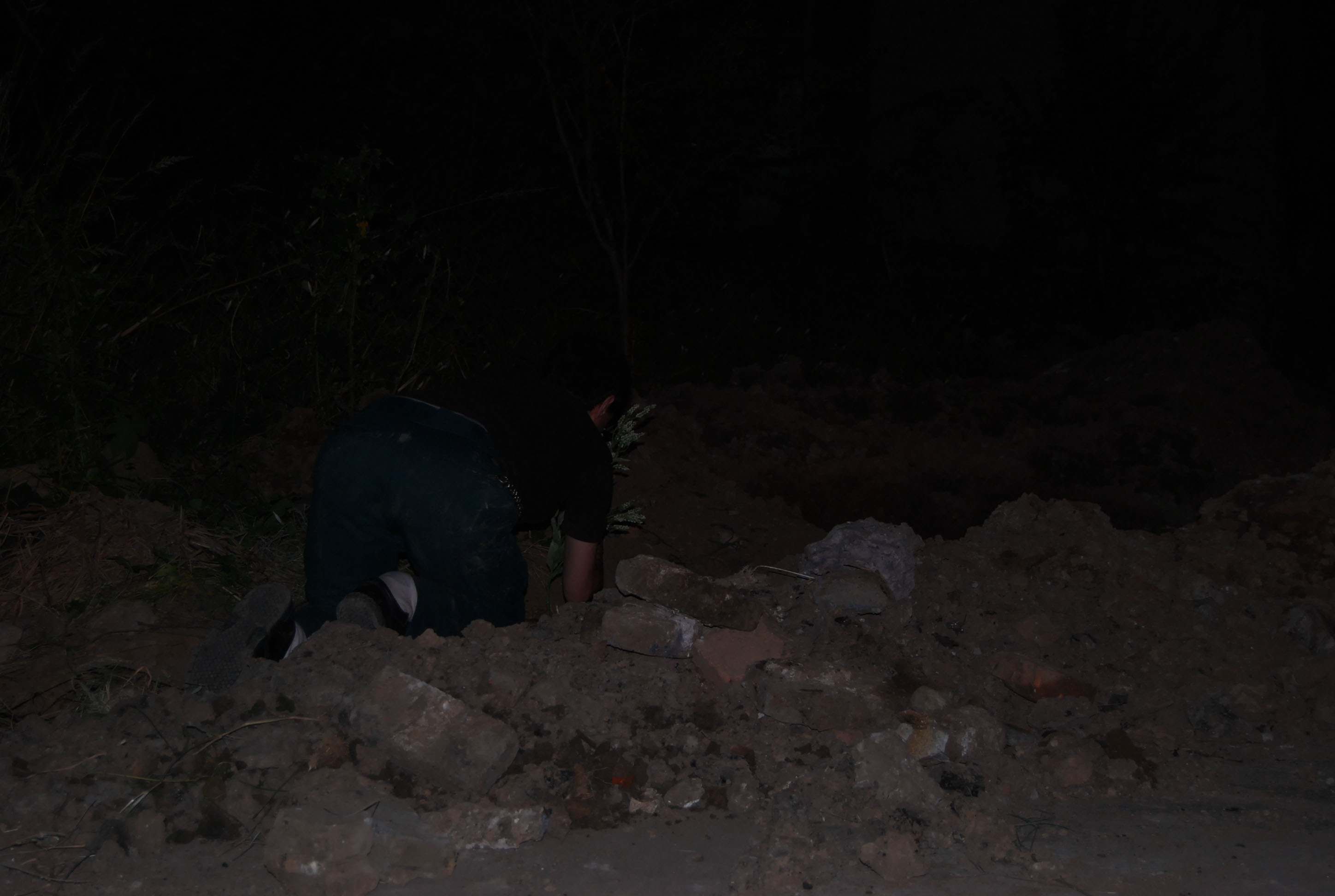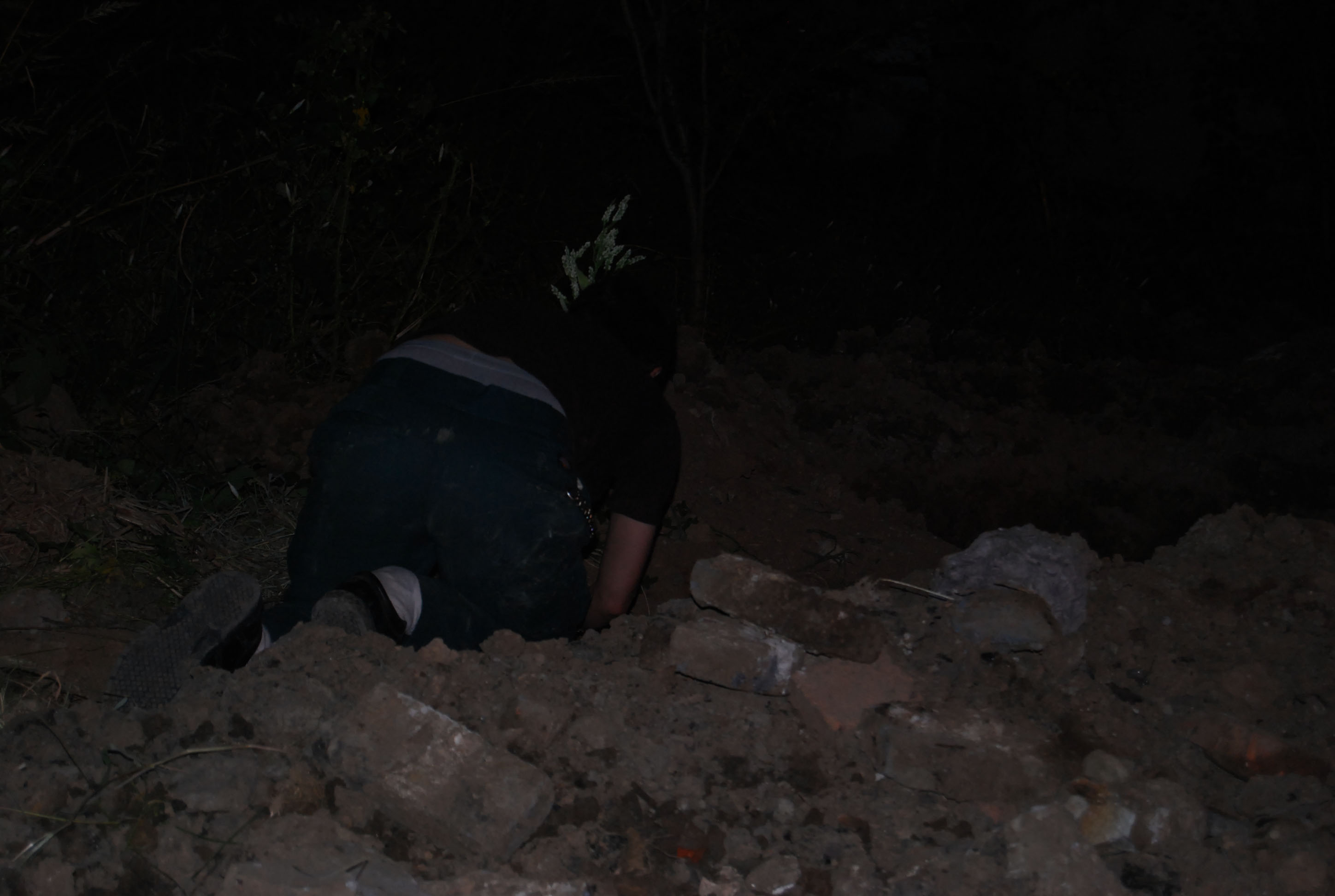Performance, 2009
Click the play button ▶︎ to view in autoplay mode. Or you can directly click on the image to advance to the next images.
Original Duration: 17min
Place: 10th Open Art Performance Festival, 798 Art District, Beijing, China
Time: September 2009
Actor: Asher Hartman
Still Image: Chenchen Wang
Video Camera; Yoshiko Shimada
Video Documentation: 8min
*Following text was handed out to the audience before the performance
The harvested potatoes were gigantic. But we didn’t feel like eating them as they had thrived from consuming the flesh and blood of the hundreds of dead bodies dumped on the fields
vegetation narrative:
A man is mourning in front of the white flower. The site is the place where his lover was killed and buried during the massacre. He comes there once in a while when he would think of his lover because he cannot forget her.
He notices the white flower. For him, the flower looks like his lover and her reincarnation. He decided to take the flower home.
When he picks up the flower, at some point, he cannot go forward anymore. (the flower is still connected to the ground through the string tied on the bottom.) He pulls it further to go forward and it is not easy. He pulls it strongly. Then suddenly, the tension is released and he feels something. He strongly feels something but he cannot see her.
Inspiration
I was inspired by the novel based on the Cheju massacre in 1943.
It is said that about 60,000 people, or one out of every five islanders, were massacred as “reds” and that 70% of Jeju’s villages were burned to the ground.
The massacre itself was horrific, but under the subsequent military regime, people were forbidden to talk about their experiences, and there was nearly half a century of silence.
In the story, there is a scene where the farmers have a rich harvest of the potato from the field in which anonymous dead bodies were buried in the previous years.
I kept thinking of the massacre and its effect on people. Their dead bodies decomposed with the support of minor creatures and became the nutrition of the vegetation on the earth, reborn as grass, flowers, trees, crops, and fruits. other animals eat them.
In a literal sense, the spirit of the dead did not die. Her hair kept growing in the ground. By the trigger of her lover who is in mourning, she reappears on the ground and walks around on the earth. She appears and disappears on the edge of life and death.
performance documentation, 10min
*The video can be watched with a donation-based contribution.
Please make an inquiry via the contact page.
パフォーマンス・タイトル
草木霊(そうもくれい)
パフォーマンスで配られた文章
収穫された芋たちは巨大だった。しかし、畑にすてられた幾千もの死体の血と肉を吸収して育ったその芋たちを、だれも食べようとはしなかった。
構想のもと
済州島の虐殺事件を題材にした小説から発想を得た。
島民の5人に1人にあたるおよそ6万人が「アカ」として虐殺され、済州島の村の70%が焼き尽くされたとされている。
虐殺自体も酷だったが、その後の軍事政権下でその体験を話すことが禁じられ、半世紀近くもの間、沈黙の時間が流れた。
コンセプト
物語の中で、とても大きなじゃが芋が豊作でたくさんとれるという場面がでてくる。しかし、そのじゃがいもは、前年に虐殺で殺された多く村人の死体の血と肉を養分にして育ったじゃが芋だったため、誰も食べようとはしなかった。
このパフォーマンスを行うまで、虐殺とその影響を考えていた。殺されて土の中に埋められた死体の肉は、無数の微生物たちの力を借りて解体され、土の中の養分となり、張り巡らされた根からその養分は吸い取られ、地上の植物たち、草・木・花・穀物・果実として生まれ変わる。動物たちはそれを食べる。わたしたちの血と骨、肉の一部になる。
彼女の髪は土の中で伸び続ける。恋人の哀しみに満ちた行為が引き金となり、彼女はまた地上に現れ、歩き出す。生と死の狭間で現れてはまた消える。
物語
ある人が白い花の前で哀しんでいる。
そこは
彼の恋人が殺され埋められた虐殺の現場。
彼は彼女を忘れることができず
思い出すたびにここにきて、
哀しむ。
彼はそこに咲いていた白い花にきづく。
その花が
まるで
恋人の生まれ変わりのように
とても愛おしくみえる。
しばらく見とれ
花を摘みもって帰ろうとする。
花を摘みとり
歩を進めると
あるとき彼はもうそれ以上を進むことができない。
花が大地から抜き取れず繋がったままでいる。
花の根元から紐がつながって
それがまだ大地とつながっている。
花を引っ張り
進もうとする。
しかし
容易には進めない。
強く引っ張る。
すると、
あるとき
引っ張られていた感覚が突然ほぐれ
解き放たれたように
彼はその場に立ちつくす。
とても強い何かを感じるが
それがなんだかはっきりとはわからない。
ただそこに呆然とたちつくす。
恋人が
土の中から這い上がってくる。
彼女は彼のそばをとおりすぎ
長い長い髪を引きずり
暗闇の中を歩いていく。
彼には彼女の姿を見ることはできない
Vegetation/ 초목 유령
파포먼스
*나누어진 글
수확된 감자들은 매우 굵었다. 그러나 밭에 뭍혀진 수많은 시체의 피와 살를 흡수해 자란 그 감자들을 아무도 먹으려고는 하지 않았다.
vegetation (초목유령 줄거리)
어떤 사람이 흰 꽃의 앞에서 슬픔에 잠겨 서 있다.
거기는 그의 연인이 살해당해 묻혀진 학살의 현장.
그는 그녀를 잊지 못하고 생각 날 때마다 그 현장에 와서 슬픔에 잠긴다.
그는 거기에 피고 있는 흰 꽃을 바라본다.
그 꽃이 마치 연인의 환생과 같이 느껴 매우 사랑스럽고 아깝게 보인다.
당분간 정신없이 보다가 꽃을 뽑고 가져 갈자는 생각이 든다.
꽃을 뽑아 몇걸음 걸음을 옮기면 어느 순간부터 그는 더이상 그 앞으로 걸어 갈 수 없다.
꽃이 땅으로부터 빼내지 못하고 연결된 채로 있다.
꽃의 끝부분에서 끈이 연결되어 그것이 아직 땅과 연결되어 있다.
꽃을 당겨 앞으로 가려고 한다.
그러나 쉽게 앞으로 가지 않는다.
강하게 당긴다.
그러면 어느 순간 갑자기 긴장이 풀려진다. 묘한 느낌에 휩쌓인다.
그는 그 자리에 우두커니 서 있다.
매우 강한 무엇인가를 느끼지만
그것이 어쩐지 분명히는 모른다.
단지 거기에 어리벙벙히 서 있다.
연인이 흙중에서 겨 온다.
그녀는 그의 곁을 지나가다가
길고 긴 머리카락을 땅에 끌어
어두운 길을 혼자 걸어간다.
그에게는 그녀의 모습을 볼 수 없다.
“당신의 무덤가에” 시:도종환
당신의 무덤가에
패랭이꽃 두고 오면
당신은 구름으로
시루봉 넘어 날 따라오고
당신의 무덤 앞에
소지 한 장 올리고 오면
당신은 초저녁별을 들고
내 뒤를 따라오고
당신의 무덤가에
노래 한 줄 남기고 오면
당신은 풀벌레 울음으로
문간까지 따라오고
당신의 무덤 위에
눈물 한 올 던지고 오면
당신은 빗줄기 되어
속살에 젖어오네


























